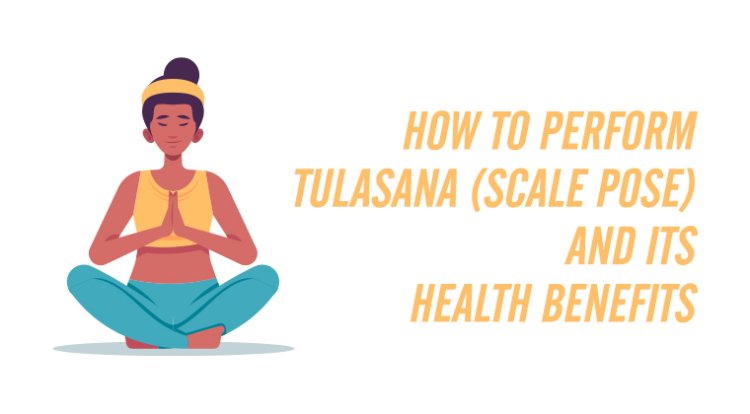How To Perform Tulasana (Scale Pose) And Its Health Benefits

What Is Tulasana?
The Tulasana pose is one such yoga Asana that is so versatile that it has enormous health benefits. The usage of this asana if it is done properly is just beyond good. This asana has several names and the ways to do it are pretty simple. In this article, we are to discuss everything about tulasana. If you are someone who is lost and want to improve life in all ways that are physical, mentally as well as spiritually then this is something which you must go for.
The Tulasana is known for the quality that it provides for a person’s life. This also has a very common name that is the scale pose. The scale poses this also helps in awakening the mind and soul spiritually. If one wants to achieve this platform then he or she needs to learn asana and yoga from an expert. The Tulasana has been derived from two words are “Tula” and ” asana”. Here the word “Tula” stands for scale and the word asana is known as posture. The reason behind this name is that in Tulasana the body needs to be lifted with the help of a hand. The body is like a scale back and forth. Due to this reason, the posture name is Tulasana.
The sitting position is often folded legs, that is the lotus posture. Thus it is also known as lifted lotus pose sometimes or seated life. This life has to be effortless and without any hesitation. This position when achieved will give proper benefit to the body and the link between the body and mind shall be generated. The soul will get its peace when this posture and effortless position is achieved. The scale pose or the Tulasana is the basic asana for several yoga poses. To be an expert in this pose one needs a lot of practice. Let’s see how to achieve the Tulasana or the scale posture.
Few Other Names Of Tulasana Or Scale Pose
The scale pose or the Tulasana is known by a variety of names. The reason for this is that this pose can be performed in many ways and forms and each of the names is derived similarly. The Sanskrit name of this pose is Tulasana or Tolasana. Next, up there are several English names as well and the English name’s are Tulasana, Utthita Padmasana which means the Raised Lotus Pose, next is Balance Pose which comes from the fact that it requires a lot of balance, and lastly Dolasana or the Swing Pose because when one is doing this pose the person seems to swing.
Few Other Names Of Tulasana Or Scale Pose
The scale pose or the Tulasana is known by a variety of names. The reason for this is that this pose can be performed in many ways and forms and each of the names is derived similarly. The Sanskrit name of this pose is Tulasana or Tolasana. Next, up there are several English names as well and the English name’s are Tulasana, Utthita Padmasana which means the Raised Lotus Pose, next is Balance Pose which comes from the fact that it requires a lot of balance, and lastly Dolasana or the Swing Pose because when one is doing this pose the person seems to swing.
Few Surprising Facts About Tulasana Or The Scale Pose
- The Sanskrit pronunciation of the Tulasana or the scale pose is pretty different and it is pronounced like toe-LAHS-anna
- The word “tola” in Tulasana usually means “balance”, “scale”, or simply “poising oneself”. Here is the main origin of Asana’s name. “Asana” as usual means “posture”. Thus from here, we see the actual meaning of the word Tulasana
- Some of the other names of this yoga pose are Scale Pose, Tolasana, Utthita Padmasana Elevated Lotus Pose, etc
- The pose can be treated as an intermediate yoga Asana in the yoga world. But for beginners, this is an absolute advanced level yoga and is quite difficult to execute as well as perform
- The chakra or focus of this posture is the Manipura chakra or the solar plexus
- The Asana is mainly performed in a sitting position. Here one needs to first sit in a relaxed manner and then the actual performance will take place
- The Asana can be mainly used to improve the strength of hands and increase the balance of the body. The body’s balance and control are increased a lot when one is performing this yoga.
How To Perform The Tulasana Or The Scale Pose?
- To perform the Tulasana one first and foremost needs to sit cross-legged where one leg is over the thighs of the other that is on padmasana
- Next place the hands beside the hip. The fingers here need to be widespread and the creases of the wrist have to face in the front side
- At this point take a deep breath and inhale deeply
- Then next exhale and at this point pit pressure on your hands and take the body up. Here the torso must be straight and tight. The arms must be strictly straight
- Then slowly lift the buttock to the ground
- The next one needs to use the thigh muscles to lift the knees
- At this stage, the entire body weight must be on the hands and only the hands must be on the ground
- Then try to move the body back and forth just like a swing
- Beginners try to hold the pose for 10 seconds and people who know how to do it can hold it as per their will
- Next, lower the legs down and come down slowly
- As you come down exhale deeply and come to the dandasana position and rest for a while before repeating.
Benefits Of The Tulasana Asana Or The Scale Pose
There are plenty of benefits that can get from the scale pose. Here next we shall discuss all the benefits of scale pose or the benefits of Tulasana.
- Stimulates the chakras because of the physical development that is involved while practicing this pose
- This yoga is based on the arms and shoulder area and thus there will be toning of the shoulders alongside the core and the wrists, arms, shoulders then the chest, hips, leg areas shall also be strong
- This asana works very beneficially for the calmness of the body as it also helps in treating anxiety and stress. This helps in concentration alongside helping people to relax
- One of the best yogas for students because this helps in balancing the entire body along with the mind. The Asana is of balance this additional mind-body balancing takes place as well
- This pose is usually also said to help in generating Muladhara (root) chakra, which is also known as the third eye which is used thoroughly in meditation as well
- Many diseases gradually can be eradicated with the practice of this asana. The Tulasana or the scale pose also helps in strengthening many body parts
- This pose helps in evolving in three ways that are physical, mental as well as spiritual
- This posture will develop a person in many ways his or her intuitive power will increase alongside the strength of the body. This also develops the patient level of a person
- This also develops the appetite of one person
- This also helps in the stimulation of great digestion
- The lower area near the stomach becomes healthy and any type of stomach-related problems are eradicated.
Thus these are the scale pose benefits or the benefits of tulasana. This posture is difficult but if one tries properly and aims to attain the goal this can be beneficial for one’s health.
Precautions
- Beginners do not attempt this posture. Try it under the surveillance of an expert
- People having knee, ankle, hip, shoulder pain must avoid this pose
- Pregnant women and women having menstruation should avoid it
- People having low blood pressure must also avoid this posture.
Thus these were all the facts about the Tulasana. This asana may be difficult in the beginning but has an immense good effect. This helps in dealing with any problems which are related to the ankle, hip, knee, or shoulder, also making these areas strong and flexible.
What's Your Reaction?


























